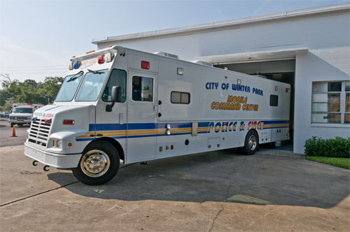September 21, 2009
How Do You Sterilize An Entire Ambulance, Airplane, Or Building? With Vaporized Hydrogen Peroxide

By Michael D. Shaw
As we gear up for a flu season that is likely to include the H1N1 (Swine) variety, along with the usual seasonal flu threats, authorities recall the SARS (Severe Acute Respiratory Syndrome) outbreak of 2003. A frequently cited article from the December 18, 2003 issue of the New England Journal of Medicine entitled “Transmission of the Severe Acute Respiratory Syndrome on Aircraft” showed that infection in a single passenger on the longest of the three flights examined resulted in illness in 22 of the 119 other passengers. The two other flights did not produce such dramatic results.
Nonetheless, the authors concluded that “The risk of transmission from a patient with SARS during an airplane flight may be significant, and further attention to measures that can reduce the likelihood of transmission is warranted.”
Flu transmission on board aircraft has also been studied, and a scary article from the July, 1979 issue of the American Journal of Epidemiology, entitled “An Outbreak Of Influenza Aboard A Commercial Airliner” describes a situation in which 72 percent of the passengers became ill, based on a single index case. The aircraft required some repairs, and many of the passengers stayed aboard the unventilated plane for up to four hours. The attack rate of the flu virus was proportional to the amount of time spent aboard during this period.
Based on these and other studies, the Federal Aviation Administration became interested in the notion of sterilizing aircraft, especially in light of the staggering losses suffered by the airline industry during the SARS outbreak, when red-tagged planes could be idled for up to seven days for decontamination. One very successful project was presented in an April, 2006 FAA report entitled “Vaporized Hydrogen Peroxide (VHP®) Decontamination of a Section of a Boeing 747 Cabin.”
The traditional appeal of hydrogen peroxide in such applications is that is breaks down to oxygen and water, distinguishing it from other effective but less environmentally friendly compounds. It is also relatively inexpensive. However, there are a number of practical issues that had to be worked out.
VHP is a registered trademark of Steris Corporation for its biodecontamination system, which had already been widely used in the pharmaceutical and health care fields—before this aircraft test. The VHP biodecontamination cycle operates in a closed-loop configuration where the enclosure (in this case an aircraft) is subjected to four phases:
- Dehumidification—Reduction of relative humidity to a pre-determined level
- Condition—Rapid increase to desired VHP concentration
- Biodecontamination—Maintenance of desired VHP concentration and relative humidity (for retention of vapor phase)
- Aeration—Rapid reduction of hydrogen peroxide vapor
Notably, the VHP process has been validated as true sterilization (destroying all forms of microbial life including viruses and spores).
In the FAA study, 51 sets of biological and chemical indicators—dispersed around the aircraft—were used to determine the efficacy of the VHP treatment. The biological indicators contained measured quantities of Geobacillus stearothermophilus spores, a notoriously hard to kill organism. The chemical indicators used in this evaluation provided a qualitative indication of the presence or absence of VHP vapor.
Once proper conditions were determined during the first two tests, better than 6-log reduction was achieved at all biological indicators. “6-log” means that 99.9999 percent of all the spores were destroyed.
OK, but what about ambulances? AeroClave LLC, based in Winter Park, FL, and founded by emergency physician Ronald D. Brown MD, was also involved with decontaminating commercial and military aircraft. Working in conjunction with Steris, AeroClave added its own magic to the VHP process, enabling it to be applied to much larger areas, and importantly, speeding up the cycle time by getting the peroxide to disappear much faster after sterilization is complete. Thus, 7-12 hour cycles could now be reduced to about 90 minutes.
This is perfect for emergency vehicles, and AeroClave has set up its Portable Asset Decontamination System, or P.A.D.S. at its Winter Park facility. P.A.D.S. is capable of decontaminating multiple vehicles including ambulances, fire/rescue and police vehicles, school buses, and other critical assets to a level equated to surgical sterility (6-log reduction). In fact, as Ron says, the city of Winter Park is the first in the world to proactively decontaminate police and fire vehicles in such a manner.
If your asset can’t come to P.A.D.S., they also have Mobile AeroClave, where the process can be brought to a client’s building. Ron tells us that “The scalability of the AeroClave System allows for the decontamination of buildings from the size of offices and restaurants, to hospitals, to even the giant Louisiana Superdome.”
One of his early assignments was to exterminate an overwhelmingly bad mold problem, that had forced the evacuation of a large video production operation. The original order called for the facility to be emptied of equipment and all sorts of other items, but this could not be arranged in time. Brown was concerned that since the building was “packed to the gills,” as he puts it, the efficacy of the process would be diminished. He was told by the client to proceed, and proceed he did.
The results were excellent. 6-log reductions on the biological indicators were achieved, and none of the sensitive items inside the building were damaged.
How often should emergency vehicles be treated with the AeroClave process? Ron feels that once per week, or after nasty calls (infectious situations or multiple trauma cases where blood can be dispersed) would be about right. Of course, EMS personnel agree, and explain that running a vehicle through P.A.D.S. is more cost-effective than the older methods of wiping down the all the surfaces by hand.
Given the prospects for a difficult flu season, not to mention a host of other pending infection control issues, many in health care look to rapid expansion of the VHP and AeroClave technologies.

